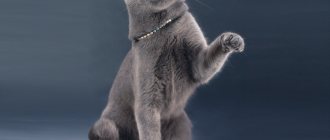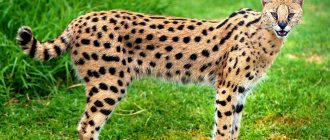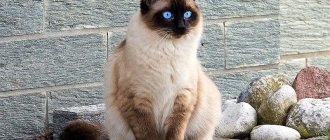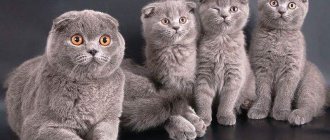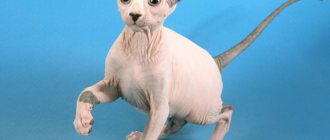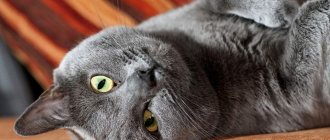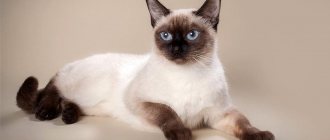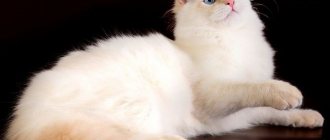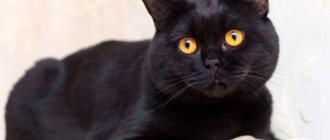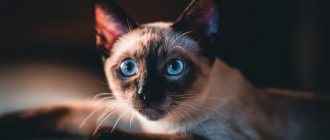“British” and “Scottish” are very often confused, but in fact these animals have many differences. The most obvious of them is the ears. Folding is characteristic exclusively of cats from Scotland, but it does not exclude straight-eared representatives from them. This feature can easily confuse an inexperienced cat lover, and the presence of lop-eared “British” cats in advertisements for the sale of kittens further increases misunderstanding.
If you don’t know how British cats differ from Scottish ones, then don’t rush into buying a pet - study detailed information about both breeds. This will help avoid deception by unscrupulous breeders.
What kind of cat breed is Scottish Fold and Scottish Straight: definition, photo
The Scottish Straight cat is a straight-eared cat bred in Scotland in the 1960s from the British cat breed.
The Scottish Straight is medium in size and appears to be quite well-fed (especially boys), due to its round cheeks that extend into a short neck. The weight of a cat is up to 3.5 kg, a cat – up to 5 kg. The legs are short, the tail is of medium length, the ears are wide at the base, pointed at the tips, spread to the sides. The eyes are large and round; because of them, a kitten, and then an adult cat, has a childish expression on its face for the rest of its life. The nose is small. The coat is thin, moderately long, as if plush, of various colors (black, gray, chocolate, brindle).
The Scottish Straight cat is balanced and easygoing, gets along with everyone in the family, but at the same time she has a sense of self-esteem. She chooses one owner, is very smart, understands every word, is curious, resistant to stress, easily tolerates moving, gets along well with other animals.
Scottish cat breed Scottish Straight
The Scottish Fold or Scottish Fold cat is very similar to the Scottish Straight in all respects, but its ears are folded forward, some folded 2 or 3 times. Also, the Scottish Fold has a shorter tail. Among Scottish Fold cats there are different characters: slow, agile, slightly aggressive, affectionate, but this breed has one feature - to remember what is beneficial to it .
Scottish cat breed Scottish Fold
Note : Only chocolate-colored cats of the Scottish breed produce litters of different colors and shades.
A Scottish kitten quickly gets used to the toilet and scratching post; the only thing it can’t stand is being forced to do anything .
Scottish cats are in good health; no genetic diseases have been detected. You can feed them :
- Canned food at room temperature, but not all the time.
- Mixed diet (dry food as the main food, and complementary foods - fish, milk, milk porridge, chicken, beef liver and meat, boiled vegetables).
Important . Fur, like the plush of Scottish cats, is difficult to remove from the stomach of the animal, so as not to harm the cat, while still a kitten, at the age of six months, it is taught to eat a special paste that removes hair.
History of the origin of both breeds
Before we figure out how “British” differs from “Scottish,” let’s look at the history of their origin. It will help you understand the reason for the existence of a large number of advertisements for the sale of lop-eared “British dogs”.
British
Due to the antiquity of the breed, it is very difficult to trace the immediate moment of its appearance, but felinologists are inclined to believe that the Roman conquerors were involved. Legionnaires from Rome used cats to catch ship rats that were encroaching on food provisions. Some of the mustachioed hunters moved from their ships to land and settled in Great Britain. As a result of natural crossing with native breeds, a completely new one emerged - the British one.
Street animals gained real popularity only in the second half of the 20th century. As a result of the active interest of breeders, a new variety was obtained - long-haired. She was bred by crossing with Persian cats, but as a result, interbreed matings were banned due to the unevenness of the resulting offspring.
Scottish lop-eared
The English name of the breed is Scottish Fold. These animals appeared as a result of a banal accident. The first owner of floppy ears, named Susie, was born in Scotland in 1961. Her mother was the most ordinary yard cat, and her father remained unknown. Having matured, Susie also gave birth to offspring, but only some of the kittens inherited her droopy ear.
A little later, felinologists found out that the gene responsible for drooping ears is dominant. When two identical genes meet, that is, when two fold-eared pets are mated, their offspring are born sick or die in the womb. For this reason, Scottish Folds can only be mated with Scottish Straights, that is, straight-eared cats.
For a long time, the breed was classified as “British”, allowing interspecific matings. A separate standard for “visloushki” was received only in 1994. For this reason, all lop-eared “British” are just mestizos, not recognized by international felinological organizations.
Scottish Straight
The history of the origin of Scottish straights is similar to Scottish folds. These are the same kittens from Susie who did not receive the lop ear gene. Numerous attempts to artificially preserve the unusual shape of the ears have led to pathologies of the musculoskeletal system.
For this reason, animals began to be bred according to a similar pattern: Scottish Straight + Scottish Fold. In such a combination, only one parent is the carrier of the mutation gene, and the offspring, although motley, are healthy.
What is the British cat breed: definition, photo
British Shorthair cat breed
According to one version, the ancestors of the British cat breed were brought to the British Isles by the ancient Romans at the beginning of our era. Of course, they didn't look the same as they do now. Over time, the cats got used to the humid and cool climate of the islands and acclimatized. The main purpose of ancient cats was to catch rodents.
The first cat show in Great Britain took place in 1871, and the cats were recognized as purebred and began to be called British.
The British Shorthair cat is larger than average in size, girls weigh up to 4 kg, boys - up to 6 kg. They are squat, with a wide chest, well-developed muscles, short thick legs and a thick tail, a massive head, thick cheeks, a small nose, and medium-sized ears. The Briton's coat is thick and short, of different colors and shades, but the classic ones are lilac and blue.
Breed Features:
- Pronounced fold of skin around the neck
- On the nose, closer to the forehead, there is a small depression
- The chin is aligned with the nose and upper lip
- Kittens have bluish-blue eyes, gradually changing to bright orange - in adults, green and blue eyes are occasionally found in this breed
- Very thick short coat, plush in appearance
British cats of these colors can take part in competitions:
- Plain
- Painting with a pattern
- Tortoiseshell (tri-colored, when one color smoothly transitions into another)
- Smoky
- Combination of two colors
- Chinchilla (faint various colors)
- Siamese color type (on the face, tail and paws the fur is darker than the rest)
The British cat is characterized by good health.
British
This aristocratic cat breed is one of the most ancient. The breeding of purebred Britons began in the 19th century, and the history of the breed began in antiquity, in the Ancient Roman era.
According to the most common belief, this breed originated from gray cats with long, sharp fangs that lived in North Africa and Southern Europe.
These cats were actively domesticated by local residents, and together with Roman legionnaires, representatives of the species that was the ancestor of the British were brought to the British Isles.
These animals were very hardy and quickly transitioned from the hot climate of the Mediterranean to the cool weather of England.
shutterstock
Officially, G. Weier is considered the creator of the breed, who selected similar-looking gray, muscular cats for mating. He was also the first organizer of the exhibition of these animals in 1861.
How do British cats differ from Scottish cats in coding: comparison
For purebred animals, a metric is created, where the pedigree is indicated.
For a purebred animal, a metric is created, where its pedigree is indicated. In order not to describe too much about the animal, all records in the metrics are entered under generally accepted coding.
The most common phenological organizations: WCF, CFA, FIFE, IFA, TICA.
The pedigree indicates:
- Number assigned by a club or association
- Animal name
- Breed (indicated in coded form)
- Parents
- Grandfathers, grandmothers, great-grandparents
- Information about other kittens from the litter
- Last name and first name of the breeder, phone number
In the phenological association WCF are designated:
- British Shorthair – BRI
- Scottish Fold Shorthair cat – SFS
- Scottish Fold Longhair cat – SFL
- Scottish Fold cat without fur length designation - SFT
- Scottish Straight Shorthair cat – SCS
- Scottish cat Scottish Straight longhair – SCL
Who is better to have
It is important to take into account the character traits of each breed of animal, the composition of the family and the purpose for which the kitten is taken into the home. If the owners are constantly busy and only appear in the evening, then they should take a Briton, especially if there are no small children.
For those who want to buy a reliable friend for their child, it is better to choose a Scot. Among the representatives of this breed there is a fold-eared cat, very beautiful and unusual. Such pets quickly become full-fledged members of the family, unable to scratch or bite: if communication with children is tired, the Scottish one will simply go to rest in a secluded place.
Representatives of both breeds are smart and calm, easy to train. They don't swing on the curtains, don't bite and don't stain guests' slippers. But if there are small children in the family, experts advise giving preference to the Scotsman.
Source
How do British cats differ from Scottish cats in character and habits: comparison
A kitten of the British Shorthair breed
The British Shorthair cat is a kind of aristocrat, she will not play with children, will not tolerate being carried in her arms, at most - stroke her fur. She is not aggressive, but prefers to be alone more time.
But the Scottish Fold and Scottish Straight cats will allow you to play with them all day long without being aggressive.
One and the other type of cat has some unusual features :
- Scottish cats can sometimes be seen standing on their hind legs, or sitting like humans - on their butts, they require such postures to straighten their spine. British cats do not have this.
- Scottish cats are afraid of heights, while British cats, on the contrary, try to climb higher.
Features of animal care
British cats, which live on average up to 18 years, usually do not complain about their health.
Scots are also not a frail breed, but due to a number of genetic characteristics, pets can have certain birth defects. Most often, Scots suffer from diseases of the musculoskeletal system. Additionally, they may have bone problems.
The floppy ears of Scottish cats often attract parasites. Therefore, owners will have to frequently inspect the ears of their pets and lubricate them with cologne or soap suds for hygiene, since it is in the hanging auditory organs that dirt most often settles.
There are several general rules that apply to representatives of both breeds.
- Both types of animals are picky about food. They should be given either high-quality homemade food or premium professional food.
- In both cases, owners are often faced with a large amount of fur. To prevent her tufts from flying around the apartment during molting, pets need to be combed.
- Britons and their northern neighbors have fast-growing nails, so they should be trimmed regularly.
- Oral problems are a common vulnerability for both breeds.
Which of the cats, cats, kittens is more expensive, smarter, larger, more affectionate, kinder: British or Scottish?
Kittens of the British and Scottish breeds
The British cat is affectionate, friendly, smart, gets along with all family members, and even other animals, is endowed with great patience, but will only do what it considers necessary. If your family is noisy and has children, a British cat is not suitable; she likes to spend more time alone.
Scottish cats (straight-eared and fold-eared) are calm, flexible, resistant to stress, do not meow unnecessarily, but only when asked to eat, are easily accustomed to order, and will play with children.
The price of British and Scottish cats depends on many factors:
- Purebred breed
- Correct execution of all documents for the cat
- The merits of the kitten's ancestors
Of course, British cats, due to the antiquity of the breed, will be more expensive.
Pros of the Scots
The Scottish cat is leaner and taller, and also less lazy. The weight of representatives of this breed rarely exceeds 4–6 kg. This is an ideal choice for children, because the cat is very playful, becomes attached to people and, as a rule, chooses a child as an idol among all household members.
Fold-eared Scots are more expensive than straight-eared ones.
Scottish cats have the following advantages:
playfulness, but without excesses;
patience with children's pranks.
A Scottish cat will never tear up wallpaper if you show her where the scratching post is. However, the pet misses its owners: if they are not at home, it can sleep all day, and when everything is assembled, it will follow around and even try to tell something. At the same time, cats of this breed are laconic and do not get bored with loud meows.
How to distinguish a British kitten from a Scottish one: comparison of kittens by breed
It is very difficult to distinguish small kittens by breed; this is possible only after 3 months of age
distinguish a British from a Scottish kitten by the following signs:
- The British breed kitten is shorter, with massive paws and stockier than the Scottish one.
- British cats have erect ears with a rounded tip.
- The Scottish kitten has a longer tail and neck, a more clearly defined chin, and an oval muzzle that resembles the head of an owl; The British have a short tail, a rounded tip, large cheeks, because of them the neck is not visible.
- You need to buy a kitten at the age of more than 3 months, because with small kittens you cannot determine who is in front of you - British or Scottish, they all have erect ears, and after 1 month of age, Scottish Fold ears begin to droop.
- The British cat breed is characterized by late maturation (cats under 3 years old, cats over 1 year old or finally after the second birth), in contrast to the Scottish breed.
Which breed is better?
Scottish and British cats have much in common in their habits and appearance. But there are specific characteristics that you need to know before getting a particular breed.
| Description features breeds | Genetic illnesses | Weight | Sociability | Special diseases | Mating |
| British | blood incompatibility | min. – 4 kg, max. – 12 kg | easily tolerates separation | obesity | careful selection based on pedigree and appearance |
| Scots | disorders of the skeleton and cartilage | min. – 3 kg, max. – 7 kg | suffers without communication | ear | crossing between stay and fold |
The choice of pet should also depend on the character and temperament of the owner.
Is it possible to breed a British cat with a Scottish cat?
Video: Why are Scots and Brits different breeds? What is the difference? Why can't they crossbreed?
The Scottish cat breed is young. At the very beginning of the breeding, it was crossed with the British cat, but studies have shown that this is harmful to both types of cat breeds.
Now, according to new requirements, in order to preserve the pedigree of British kittens , a cat and a male cat of the same color are selected for mating.
It is also impossible to breed fold-eared cats and female cats together - this leads to kittens being born with bone abnormalities (curvature of the spine, crooked legs, thickened tail). Now Scottish Folds and Scottish Straights are being bred together, and the offspring are half like the dad and half like the mom.
Differences in Personality
Scottish cats have a gentle character. They are more willing to compromise than the British. The Scots are affectionate and sociable, they follow the one they have chosen as the owner, and enjoy contact with family members. They often find a common language with children, but this does not apply to all representatives of the breed. Scottish cats love active games, travel and exhibitions. They will not refuse to walk outside if the owner takes care of safety and puts a harness on the pet.
Scottish cats may stand on their hind legs when they are curious or want to attract their owner's attention.
The British are called aristocrats. They are calm and sedate, sedentary and majestic. They are more inclined to observe what is happening than to participate in anything. The British are not very demanding: if they are hungry, they will not ask loudly, but will wait silently
They are unobtrusive and are well suited for those people who do not like their pets to attract attention.
Scottish cats have amazing artistry, flexibility and charisma: they even like to sit like a human, not like a cat.
My sister has a British cat, and I have a Scottish cat at home. My favorite is not as affectionate as in the descriptions of the breed: she can bite if she doesn’t like something, and she doesn’t like to sit in your arms. Before castration, the cat often hid from me or sat in her house
But now she often comes up and asks to pet her and doesn’t mind if I do it spontaneously, but my sister’s cat doesn’t like unnecessary attention to herself. When guests arrive, he climbs up and sits there
Mine loves meeting new people, although she spends a long time sniffing around. Both my cat and my sister’s cat don’t like children: they hide behind the furniture. Mine, however, will hiss at first and may bite. The Briton is more patient, but he clearly doesn’t like intrusiveness. From my experience, the Scots are better suited for those who want a cat as a companion. The British make contact and play with pleasure, but it is difficult to expect signs of attention and devotion from them.
Which of the cats, cats, kittens is better to buy or get: a British or a Scotsman?
British breed cat
If you are going to buy a Scottish or British kitten, you need to follow some tips:
- Before buying a little fluffy, check the metrics, medical record, and make sure that the necessary vaccinations have been completed.
- If you have a family without children and are rarely at home, you need a British man, he loves to be alone.
- Scottish cats love communication more, constantly hang around their owners, play well with children in outdoor games, but do not tolerate being squeezed or tormented.
So, now we know how to distinguish a British cat from a Scottish one.
Who to choose and how to choose?
If the British have the same mating as everyone else, then the Scots are not so simple. In order for a Scottish kitten to be born healthy and without defects, it is better to mate a straight-eared Scottish female and a Scottish Fold, or vice versa. A mixture of one species is often unviable, so such a union is prohibited by law. British kittens are suitable for busy people, but Scottish kittens do not like to be left alone. When you managed to decide what kind of kitten to get, all that remains is to find out how to choose a purebred and healthy pet.
You can also find “British Fold cats” in advertisements; this is alarming, since such a breed does not exist. Such “breeders” often have not purebred British cats at all, or a mixed kitten - a cross between a British cat and an ordinary cat. But distinguishing a British kitten from an ordinary one is not so easy, although it is possible. If you compare a simple and a purebred, you can understand that a purebred has a curved nose like a duck. It is not difficult to distinguish a fold-eared Scotsman, but a straight-eared one can be confused with a mongrel.
History of the British and Scots
The dynasty of fold-eared beauties dates back to the 60s of the 20th century. Scotland is considered the homeland of pets with folded ears. The ancestor of unusual babies is called the cat Susie, whose litter included both lop-eared and straight-eared pets.
Representatives of British cats were brought to England by Roman soldiers. The dexterity and skills of the mousecatchers attracted the attention of the residents. Breeders were interested in the appearance of the plush cat, and at a specialized exhibition in 1871 in the capital of the country, a decision was made to breed British cats as an independent breed.
